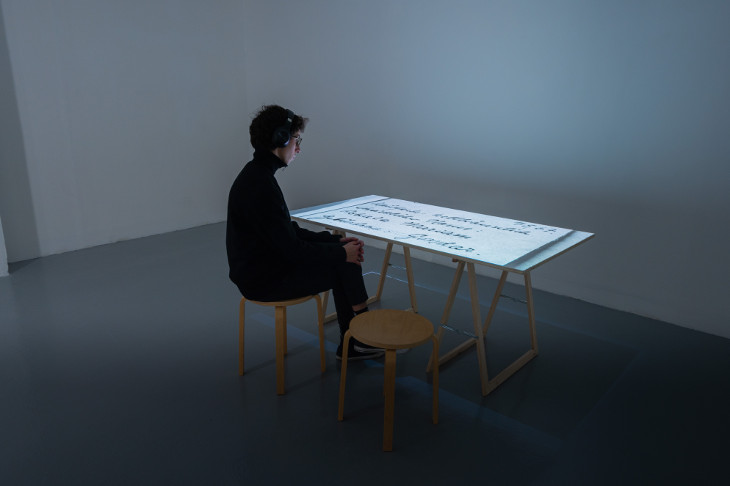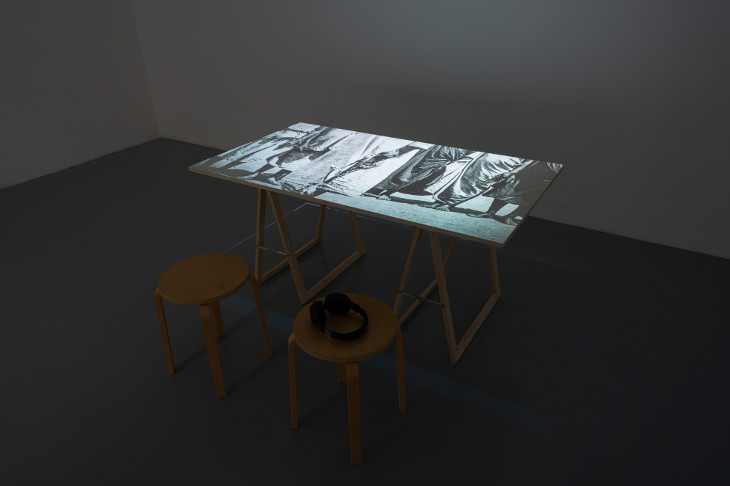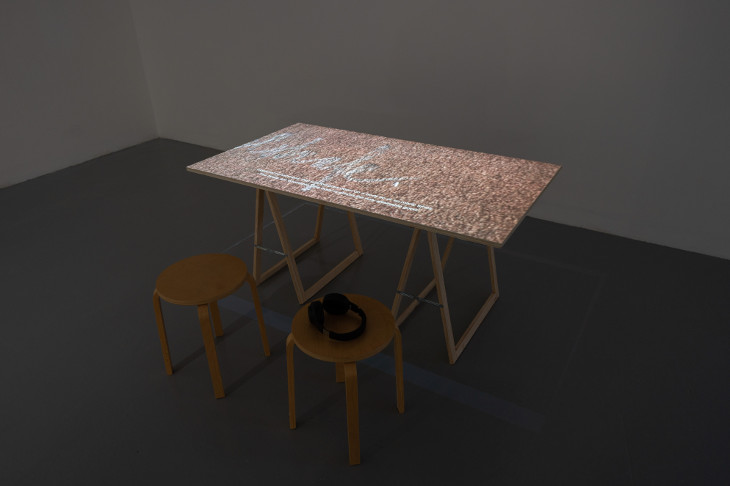The Intolerable Straight Line
Falk Messerschmidt, Remains to be seen, 2019
Film, 13 min
The following is an interview with the artist conducted by Perrine Pajot and Marie Yousself with added questions by Julia E. Dyck.
What does the term “trajectory” evoke for you?
Well first of all it‘s a rather uncommon term in German, one that is purely physical and without the various figurative trajectories of meaning it takes on in English or, I assume, in French. In the work I‘m presenting in the show, I‘m examining various trajectories. Those of distance and proximity, text and image, past and presence and of course their respective intersections and translations.
What have you contributed to the exhibition at the Galerie Art & Essai?
An essay film about “reading” and manipulating colonial images.
Is the question of the collective important to your artistic practice?
Not necessarily. I have realized some collaborative works which proved really fruitful, but I occasionally found them also to be a bit strenuous. Having said that, I really like the dynamic of the Art by Translation program, which generates a lot of synergies and a good balance between independent work and feedback rounds.
How did this new work originate?
I‘ve always been fascinated with the intricacies of combining image and text. To a certain degree, most of my previous works deal with the question of translation, namely the translation between text and photographic images. Six years ago I spend my winter in the photographic archive of the Institute of Regional Geography, which contains and handles the legacy of explorers, cartographers and anthropologists. This experience served as the starting point for the collaborative work Future is a Foreign Tense which let to the exhibition project Les statues meurent aussi. Both examine the vast amount of colonial vestiges that are hidden in plain sight in the Île-de-France region. In my new work I‘m revisiting these archival images. The insights in the history of colonialism I gathered in the interim allow a whole new angle of vision - a new trajectory, which I hope to transmit in Remains to be Seen.
Can you tell us about your future projects?
I started researching in a vast archive of GDR agitation and propaganda images in the Federal Archives - about 100000 images. It‘s mainly slide lectures accompanied by a soundtracks, like a power point avant la lettre. On the one hand they were used to promote the merits of both communism and socialism to workers, pupils and students, on the other hand they denounced capitalism. It‘s interesting to note that these images have been completely forgotten in the past 30 years, but haven‘t quite vanished from people‘s minds and that hence play an important role in the current political climate, especially in the east of Germany.
Can you speak about your relationship to archives in general as well as your relationship to this particular archive?
Figuratively speaking I‘m suffering from archive fever for quite some time now. The archive is said to be the cradle of history. It is its tomb as well. Moreover it is a center of political power and the foundation of consensus memory. It is the place where I go to intentionally stumble across new projects. Rather than trying to find proof or counterproof to verify a certain theory, I follow a vague desire to unbury something lost. Therefore I prefer physical archives over the vast archive that is the internet. There‘s something special about the historical images. Maybe it is their presence as objects.There‘s a factualness to them. For, aside from their subjectivity and forgeability, there‘s something of an inextinguishable belief that these objects and images bear testimony of something that has happened, of someone, who was once alive. When it comes to the archive of the Leibniz Institute of regional geography, I especially enjoyed having a lot of trust conveyed in me and hence a certain liberty in working there. I had the chance to basically be on my own and see everything. The physical simultaneity of and the proximity to the images created fascinating chance encounters which, in turn, led to a certain intimacy, a deceptive sense of feeling at home. Yet browsing through a cornucopia of photographs also came at the price of a certain image fatigue. Hence, it took me a few years to fathom the intricacies of these photographs. Or at least to have an idea of the trajectories that they imply.
Were you researching the way one interacts with images as well as the images themselves?
To a certain extent, yes. Commonly the organization of archives is rather hostile to chance encounters. Physical access is restricted whenever possible. If it is granted, one has to know precisely what one is looking for. I think this is partly why archivists are often overwhelmed by artists seeking to work with archives, since their interests are often vague. It was only in hindsight that I properly reflected my initial interaction with these images, which was one of obscuration and obliteration through the means of wrongly applied photographic reproduction. When I first saw them my impulse was to transform them, to deprive them of their abrasiveness. I revisited the archive several times in the last 5 years and as I was learning more about the historical background of the images as well as the discourse of colonial images (or photography in general) I was able to interrogate and elaborate my initial approach which in turn led to Remains to be Seen.
What factors influenced your choice of images to use in the film?
Initially I had an interest in images that revealed multiple layers of narratives that I could potentially excavate by applying different framing, that rendered the gaze of the photographer explicit for example. Or fraudulent and resisting ones, where certain elements would contradict the intention of the author. Or those that revealed the intention in a more than explicit way, those that to my eyes conveyed a horror in terms of how the people photographed were looked at - and the way these gazes were returned by the subjects. Other aspects were physical traces, photographs that record time in a different way, damaged or dusty ones. Or images that had been removed from the albums and for some reason had disappeared.
There is a strong synchronicity between the spoken essay and the movement of the images. Did the script determine film or vice-versa?
It was more of a see-saw process of mutual information where the images would vivify my ideas which, in turn, necessitated other images to become part of the narrative. — A constant updating and mutual stimulation of the visual and the textual. Yet in terms of timing and synchronicity I would suggest that the text has the final say.
You’ve chosen to project the film onto a table where the spectator is seated. What made you choose to display the work in this way?
The choice was intuitive. I liked the idea of a repetition of the process of photographic reproduction the images laying flat on a support. The table is a working table, a board on stands. There‘s the idea of manipulation on the one hand and the idea of taking part in a lesson on the other. Additionally, the film interrogates the notion of the right distance which is echoed in the display. If one is seated comfortably at the table, the text is readable but the images are skewed. Standing up entails a certain discomfort. I think the reading of these images benefits from this. They require to be looked at in an environment other than slumbery cinematic regression.
An interview conducted by Perrine Pajot and Marie Yousself (seminar “Listening to the Archives”, Master of Fine arts, Université Rennes 2). With added questions by Julia E. Dyck


